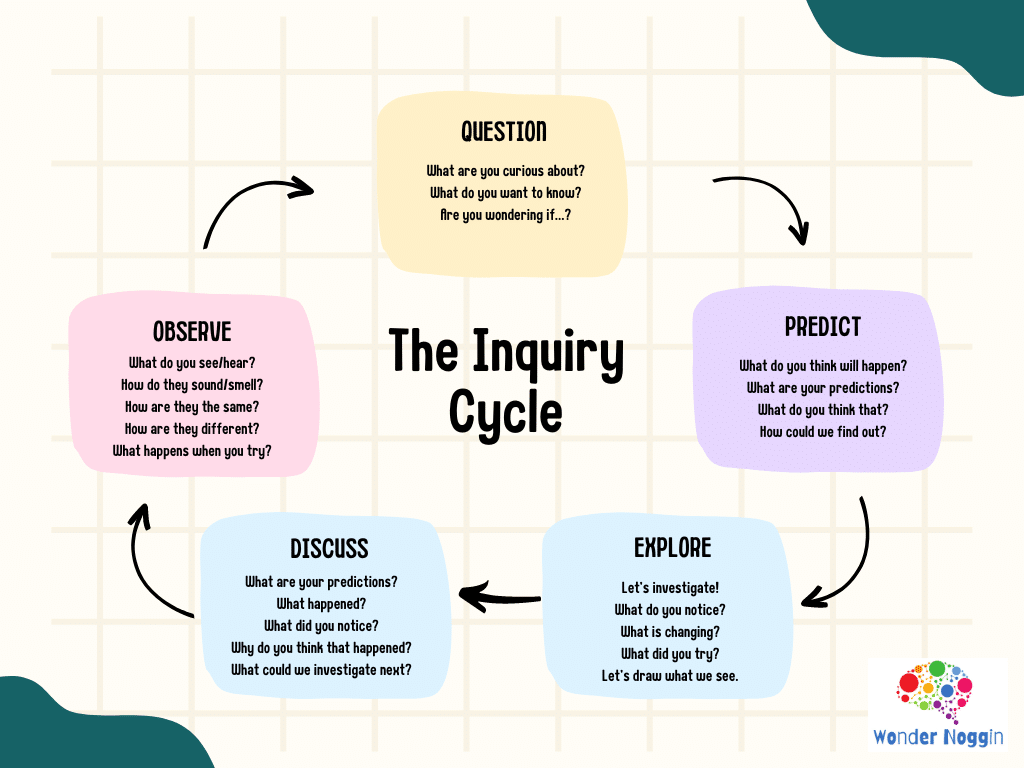In the delightful dance of STEAM (Science, Technology, Engineering, Art, Mathematics), sparking genuine interest in our little ones is the true goal.
Tailored for dedicated parents like you, this post blossoms with practical insights, turning everyday moments into rich STEAM adventures.
Together, let’s navigate this path, ensuring our children’s hearts and minds embrace the wonder of STEAM. Ready for this heartwarming journey?
Speak The Language Of STEAM
When introducing STEAM education to children, the choice of words is crucial, as it cultivates curiosity and equips them with the appropriate vocabulary. Parents should use terms like “predict,” “measure,” “observe,” “experiment,” and “calculate.”
These words provide a correct terminological base for STEAM fields and prompt children to think critically and analytically. Using such language encourages a growth mindset, reinforcing the idea that these fields are about exploration and discovery. Using the right language is vital when you teach your preschooler STEM, since it builds the foundations needed to excel in all things STEM/STEAM.
You can encourage your child to think creatively and solve problems with specific words and language like:
- Let’s observe…
- Let’s investigate…
- Let’s discover…
- Please explain…
- What is similar/different between…
- Let’s compare/contrast…
- We can measure…
- Let’s count…
- What’s your hypothesis about…
- Let’s explore…
- We can experiment…
- We can test…
- Let’s record…
- What do you guess is…
Your interactions with your children can stimulate curiosity, introspection, and analytical thinking. By infusing everyday activities such as cooking, playing with toys, or outdoor exploration with a STEAM-oriented dialogue, you can turn your home into a vibrant hub of learning and problem-solving.
Regardless of the child’s age, integrating these words into daily conversation promotes a lifelong love for learning and a propensity towards STEAM.
You Can Teach STEAM Anywhere!
When I first started teaching my son the basics of STEAM education, I thought I needed a stringent set of lesson plans and ridgid STEAM lessons to help him understand concepts. However, I quickly learned that I could put together STEAM projects right at home and help my son grow by addressing real-world problems and hands-on learning with items around our house.
You can seamlessly integrate STEAM learning into everyday life; no special toys or designated activities required. The key is to encourage curiosity and critical thinking in your child throughout the day, no matter where they are in the home.
For instance, while preparing meals, talk about the process of cooking in terms of heat, reactions, and measurements, stirring a curiosity in science and math. During cleanup, discuss the properties of water and soap, introducing basic chemistry concepts.
When outside, turn your attention to the natural world. Discuss weather patterns, plant growth, or the physics of a thrown ball.
Encourage creative thinking by posing open-ended questions like “What would happen if…?” or “How does this work?” These prompt your child to think critically and engage with the world in a meaningful, STEAM-focused way. The beauty of STEAM is that it’s all around us – it just needs to be noticed and explored.
In The Kitchen
The kitchen can be a great learning environment for kids, and it can serve as an everyday laboratory for STEAM learning. Parents can harness the magic of everyday tasks, from cooking to cleaning, to teach fundamental principles of science, technology, engineering, art, and mathematics.
The key lies in creative exploration, curiosity and making connections to real-world applications. Here are some of my favorite ways to encourage STEAM teaching through activities right in the kitchen:
- Edible Experiments: Engage children in hands-on experiments that incorporate elements of science, technology, engineering, art, and mathematics. For example, you can guide your kids in creating homemade ice cream using a chemical reaction involving ice, salt, cream, and flavorings. This activity introduces concepts of phase changes, temperature, ratios, and experimentation.
- Recipe Reinvention: Encourage children to unleash their creativity by reinventing recipes. You can provide a basic recipe, such as a muffin or pizza dough recipe, and challenge your kids to modify it by adding new ingredients, experimenting with different measurements, or exploring alternative cooking methods. This process fosters critical thinking, problem-solving, and experimentation skills.
- Kitchen Chemistry: Teach kids about the science behind cooking by exploring chemical reactions and transformations. For example, demonstrate how baking soda and vinegar react to create carbon dioxide bubbles, and explain the role of the acid-base reaction. Additionally, discuss the Maillard reaction while browning meat and how it enhances flavor and texture. This activity introduces chemical concepts in an engaging and edible manner.
- Food Art and Geometry: Combine artistic expression and mathematical concepts by encouraging children to create food art using geometric shapes. You can provide various fruits, vegetables, and other food items and challenge your kids to design and construct edible sculptures or tessellations. This activity enhances spatial awareness, geometry comprehension, and creativity.
- Data-driven Baking: Introduce children to the principles of data analysis and experimentation by involving them in baking projects. You can guide your kids to conduct taste tests or compare different variables, such as oven temperatures or ingredient ratios, to analyze the impact on the final product. This hands-on approach helps children understand the importance of collecting data, making observations, and drawing conclusions in a delicious way.
During Bath Time
Bath time can be a fantastic opportunity to introduce STEAM concepts and strengthen the creative process with your children. The tub becomes a fun-filled STEAM classroom (all while your little one gets cleaned up) where they can explore principles of physics, biology, and chemistry.
With creativity and playfulness, you can transform ordinary bath times into extraordinary learning experiences full of bubbles, colors, and wonder. Here are a few ways I have been able to encourage critical thinking skills with my son during bath time:
- Water Experiments: Use bath time as an opportunity to conduct simple water-based experiments. For example, you can demonstrate concepts of buoyancy by introducing different objects into the water and discussing why some float while others sink. They can also explore the effects of temperature by adding hot or cold water and observing the changes. This helps children learn about basic scientific principles while having fun in the bath.
- Bath Toy Engineering: Encourage children to engage in engineering challenges with their bath toys. You can provide materials such as empty plastic containers, cups, and funnels and ask their child to design a water flow system using these objects. This promotes critical thinking, problem-solving, and spatial awareness skills as children figure out how to manipulate the flow of water through their creations.
- Bath-time Art: Incorporate artistic expression into bath time by introducing watercolor paints or bath-friendly markers. Encourage children to create vibrant artwork on the bathtub walls using these tools. You can discuss color mixing, and patterns, and even encourage storytelling based on the artwork. This activity fosters creativity, and imagination, and helps children explore the connection between art and science.
- Floating and Sinking Exploration: Help children understand the principles of buoyancy by introducing objects with different properties during bath time. You can offer various items like small plastic toys, sponges, or fruit slices and ask their child to predict whether they will sink or float. Children can then test their predictions, discuss the outcomes, and learn about density, volume, and water displacement in an interactive way.
- Bubble Science: Use the creation of bubbles during bath time to teach children about the science behind it. You can experiment with different bubble solutions and bubble wands to explore the factors that affect bubble formation, such as surface tension and airflow. They can also introduce concepts like bubble shapes and discuss why bubbles tend to form spheres. This activity encourages curiosity, observation, and understanding of scientific phenomena.
Book Reading
Reading books together can serve as a wonderful avenue for STEAM education and project-based learning. You can stimulate your children’s curiosity by discussing the science, technology, engineering, art, and math concepts embedded in the stories that you read each night before bed.
Books are a great educational resource that encourages critical thinking, sparks the imagination, and helps children to see STEAM in everyday life. Here are some of my favorite ways to address STEAM subject matters while I read books with my son each night before bedtime:
- Engage in hands-on experiments: Choose books that introduce scientific concepts and conduct simple experiments related to the topics discussed. For example, after reading a book about the water cycle, encourage your child to create a mini water cycle using a glass jar, water, and a plastic bag. This interactive approach helps children understand scientific principles while making the learning experience enjoyable.
- Integrate art and design: Select books that explore the intersection of STEAM education. After reading such a book, encourage your child to create artwork inspired by the story or the scientific concepts discussed. For instance, if the book revolves around space exploration, have your child design and draw their own spaceship or alien planet.
- Build models or structures: Choose books that feature engineering or architecture themes. Following the reading, challenge your child to build models or structures using everyday materials like blocks, LEGO bricks, or even recycled items. For example, if the book is about bridges, ask your child to design and construct a bridge using popsicle sticks and glue, testing its strength and stability.
- Explore coding and technology: Opt for books that introduce coding or technology-related topics. After reading, encourage your child to engage with coding platforms or educational apps that provide interactive coding experiences for children. Some books even come with coding activities or puzzles, allowing kids to learn programming concepts while following an engaging storyline.
- Encourage critical thinking and problem-solving: Select books that feature mysteries or puzzles that require problem-solving skills. After reading, discuss the challenges or dilemmas presented in the book with your child. Encourage them to think critically and come up with creative solutions. This approach helps foster analytical thinking and problem-solving abilities, which are essential in STEAM fields.
Use Regular Materials Around The House
You can turn everyday household items into engaging STEAM learning tools. With creativity and curiosity, regular materials can be repurposed to demonstrate scientific concepts, engineer simple machines, create art masterpieces, solve mathematical problems, or explore the wonders of technology.
This makes STEAM learning accessible, practical, and fun right at home! Here are some ways I have found it easy to make your home a STEAM classroom without a lot of effort by using regular items around the house:
- Build a Rube Goldberg machine: Rube Goldberg machines are elaborate contraptions that perform a simple task through a series of chain reactions. Encourage your child to use everyday items like dominoes, ramps, balls, and household objects to create their own Rube Goldberg machine. This activity incorporates elements of physics, engineering, and problem-solving.
- Conduct kitchen chemistry experiments: The kitchen is a treasure trove of materials for teaching chemistry to children. From baking soda and vinegar reactions to making homemade slime using cornstarch and water, there are numerous hands-on experiments you can try. These activities will introduce your child to basic scientific principles and foster their curiosity about the world.
- Design and construct a cardboard city: Use cardboard boxes, tape, and other craft supplies to create a miniature cityscape. Have your child plan and build different structures like houses, skyscrapers, and bridges. This activity promotes architectural and engineering skills, as well as creativity and spatial reasoning.
- Create a recycled art gallery: Gather various recyclable materials such as plastic bottles, cardboard tubes, old magazines, and scrap paper. Challenge your child to repurpose these items into artwork. They can make sculptures, collages, or even functional objects like pencil holders. This project encourages creativity, resourcefulness, and environmental awareness.
- Build a simple circuit: Introduce your child to the basics of electronics by building a simple circuit using materials like aluminum foil, batteries, LED lights, and paper clips. Help them understand how electricity flows and how different components work together to create a functioning circuit. This hands-on activity develops their understanding of electrical engineering and sparks an interest in technology.
Model What A Culture Of Inquiry Looks Like
Modeling a culture of inquiry is about fostering curiosity and encouraging questions. As parents, we can demonstrate this by exploring the world around us with a sense of wonder, asking questions, and seeking answers together with our children. This mindset, when applied to STEAM, inspires kids to investigate, experiment, and create. Remember, every question is a step towards learning, and every exploration is a journey into the heart of STEAM.
Let’s take a look at some simple ways for you to encourage your little ones to develop a mind of inquiry.
Model A Questioning Mind
You can model a questioning mind by demonstrating your own curiosity and asking thought-provoking questions. Encourage discussions about everyday observations, encourage them to ask “why” or “how” questions, and engage in problem-solving together.
By modeling curiosity and an inquisitive mindset, you inspire your children to become active learners and critical thinkers.
Be An Active Observer
You can model active observation by demonstrating curiosity and attentiveness when exploring the world with your children. They can point out interesting details, ask thoughtful questions, and encourage their child to notice patterns or make connections.
By actively engaging in observation, you can inspire your children to develop keen observational skills and a genuine appreciation for the world’s wonders.
Know When To Intervene
It is crucial to know when to intervene with your child to keep them on task during STEAM learning. Pay attention to signs of frustration, disengagement, or distraction.
Step in when they seem overwhelmed or stuck, providing guidance and support to help them regain focus and momentum in their learning journey.
Explore Together
To support the learning process, you should actively explore with your children. By engaging in hands-on activities, conducting experiments, and visiting educational sites together, you demonstrate the importance of curiosity, discovery, and lifelong learning.
Exploring alongside their children fosters a sense of shared inquiry and encourages a deeper understanding of STEAM concepts.
Talk With Your Little Ones
When engaging in STEAM activities with their children, you should foster open and meaningful conversations. Encourage active listening, ask probing questions, and provide constructive feedback.
Create a safe space where children feel comfortable expressing their thoughts, ideas, and challenges. This dialogue cultivates a culture of inquiry and strengthens the parent-child bond.
Provide Children Time To Explore
You should provide children with ample time to explore on their own during STEAM learning. Allowing uninterrupted periods for independent exploration encourages children to follow their own curiosity, make discoveries, and develop problem-solving skills.
It fosters a culture of inquiry where children can take ownership of their learning and develop a sense of autonomy.
Encourage The Inquiry Cycle
The inquiry cycle is a powerful tool that you can use to help your children learn STEAM concepts. It is a process of asking questions, investigating, exploring, and reflecting that fosters curiosity, critical thinking, and problem-solving skills.

Throughout the process, emphasize the importance of perseverance and embracing failures as learning opportunities. Encourage your child to revise their ideas and strategies based on new information. This iterative process helps them develop a growth mindset and resilience.
You can also make the learning process fun by guiding your little ones toward various kids coding languages. Several programming languages are available for young learners, and you can make the process to understand computer science and other areas fun and rewarding for their young minds!
By guiding your child through the inquiry cycle, you are fostering their natural curiosity, encouraging them to ask questions, and empowering them to explore and discover the world around them. It’s an effective way to instill a love for STEAM and cultivate essential skills that will benefit them throughout their educational journey and beyond.
- Encourage curiosity: Foster your child’s natural curiosity by encouraging them to ask questions about the world around them. Help them identify topics or phenomena that spark their interest and guide them in formulating meaningful questions.
- Explore together: Support your child’s exploration by providing them with resources, such as books, websites, or educational videos, that can help them gather information about their chosen topic. Visit libraries, and museums, or go on field trips to further enhance their learning experience.
- Hands-on experiments: Engage your child in hands-on activities and experiments related to their inquiry. Encourage them to apply what they have learned and provide them with materials and guidance to conduct their own investigations. This hands-on approach fosters a deeper understanding of STEAM concepts.
- Reflect and discuss: Regularly engage in discussions with your child to reflect on their findings and observations. Ask open-ended questions to encourage critical thinking and help them draw connections between their discoveries and real-world scenarios. Encourage them to articulate their thoughts and explain their reasoning.
- Embrace failures and revise: Teach your child that failures are an integral part of the learning process. Encourage them to embrace mistakes as opportunities for growth and improvement. Guide them in revising their ideas, strategies, or experiments based on new information they acquire during their inquiry. This iterative approach promotes resilience and the development of problem-solving skills.
Teach Your Little Ones The Basics Of STEAM For A Bright Future
As we conclude this exploration into home-based STEAM learning, remember that the journey of discovery is as vital as the knowledge gained. Teaching the language of STEAM, building skills, and fostering a culture of inquiry can happen anywhere, anytime.
With these tools, you can guide your child’s STEAM adventure. Here’s to igniting curiosity, encouraging creativity, and inspiring future innovators, right within the comfort of your home!







0 Comments